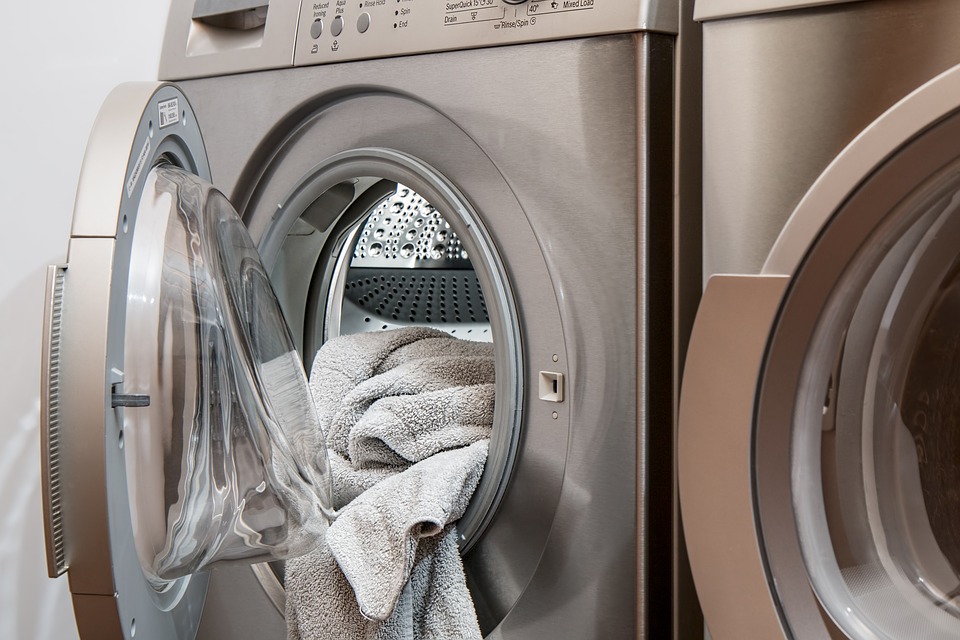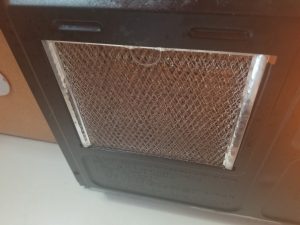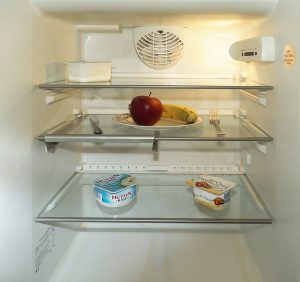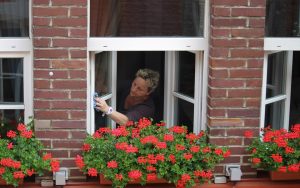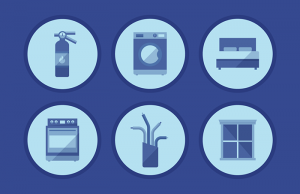
Has your air conditioner ever failed on a hot summer day? It’s a struggle no homeowner wants to deal with. When you own a home it’s important to budget annually for repairs that might be needed and anticipate when things might need to be replaced.
If you take care of your home, your appliances and fixtures should last longer. This means keeping them clean, performing regular maintenance and preventing unnecessary wear.
Even the most well-kept homes will need repairs at some point and it helps to know how long you should expect your items to last. We’ve put together a list of how long certain household fixtures and appliances should hold up.
Check out each of the rooms below!
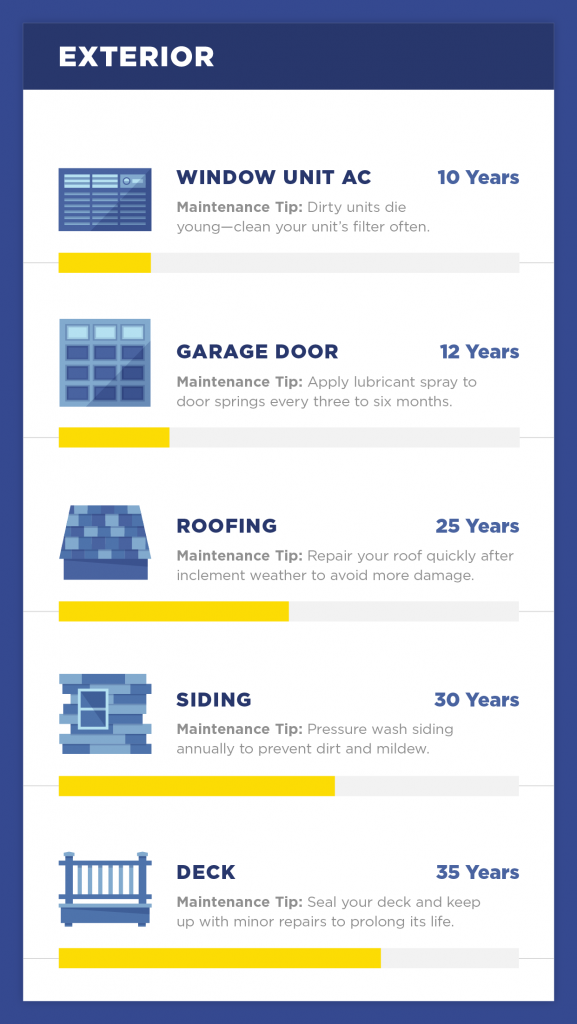
Exterior:
Fixtures outside your home can suffer the most wear and tear of anything you own because they are constantly exposed to the elements. However, they are usually some of the most sturdy and are typically built to last. These are the items you will likely have to pay more for but luckily not as often.

- Window Unit Air Conditioner: 10 Years
The typical window unit air conditioner can last anywhere from 8–12 years depending on how much it’s used and how well it’s taken care of. Be sure to turn the unit off when it’s not needed and clean the air filter often.
You can expect 10–15 years of reliable service from a garage door depending on how often it’s used. To prolong its life, apply lubricant spray to door springs every three to six months.
Siding can last anywhere from 20–40 years depending on the material used, weather conditions in your area and how well it’s taken care of. For instance, aluminum siding will last 15 years but needs to be repainted when it fades every five or so years.
Wood siding that is painted or stained every five years should last decades. But vinyl siding is a popular choice because it can last up to 40 years and is virtually maintenance free!
No matter what material you use to keep your siding clean to prevent dirt and mildew that can shorten its lifespan.
Most homeowners will need to re-roof their house every 20–30 years, although the type of shingles you use will impact this number. A metal roof can last even longer, up to 50 years, although it’s more expensive upfront and therefore less common.
To get the longest life out of your roof ensure you check it after inclement weather and be sure to repair it quickly to avoid more damage.
Depending on the type of wood, your deck can last anywhere from 20–50 years. However, the average deck lasts around 35 years.
Seal your deck and keep up with minor repairs to keep it strong and sturdy for many years.
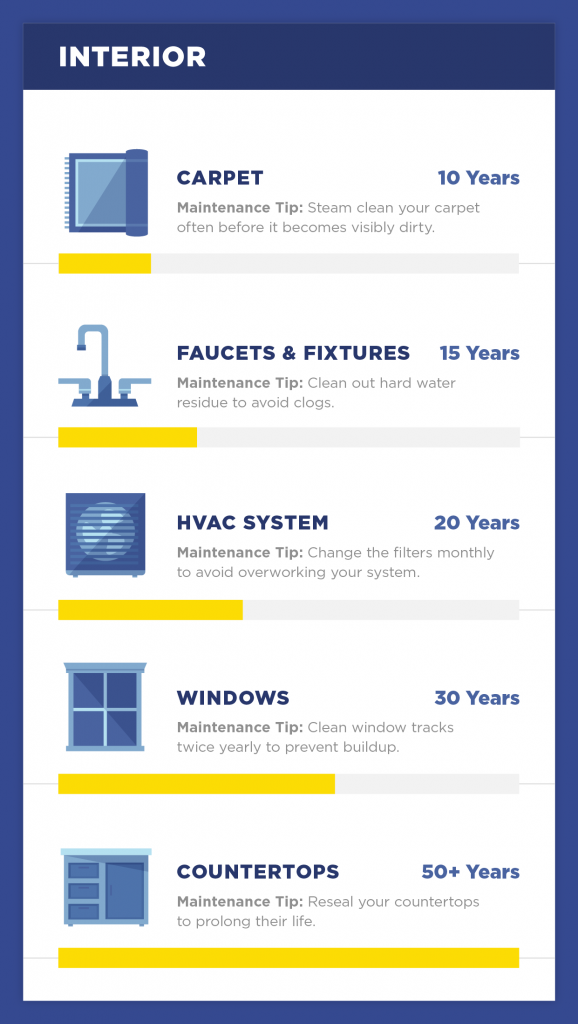
Interior:
Maintaining the interior of your home can keep it looking stylish and new. Even the most diligent cleaners will at some point have to replace worn out fixtures. Doing so proactively can help you avoid an emergency situation.

Carpet in your home typically has a 5– 15-year lifespan. It will eventually begin to wear out (in the most traveled areas) and it will need to be evaluated. If you notice it’s starting to look dirty, matted or has a foul odor, it’s time to replace it.
It’s a maintenance best practice to steam clean your carpet often (before it becomes visibly dirty).
- Faucets and Fixtures: 15 Years
Properly cleaned and maintained faucets and fixtures can last anywhere from 10–20 years. However, if they are not properly cleaned they can last less than 10 years. If you want to make them last, clean out hard water residue often.
It’s best to replace your system around 15 years which means saving up the money and having a professional in mind to fix it.
To get the longest life out of your HVAC change the filters often to avoid overworking your system.
- Windows and Skylights: 30 Years
Windows and skylights last so long that often people forget they need to be replaced at all. Good windows will last most people from 25–35 years or more, but you will know it’s time to change them when they start looking warn, begin to suffer damage or are not insulating your home properly.
Be sure to clean window tracks twice yearly to prevent buildup and prolong their life.
- Countertops: 15-100+ Years
It’s smart to invest in stone countertops such as granite or quartz because they last so much longer than laminate or cement countertops. Laminate countertops will last anywhere from 10-12 years, while a well-maintained stone countertop can last over 100 years!
Keep your investments safe by avoiding contact with hot surfaces or cutting directly on them. Reseal your stone countertops often and they can last a lifetime.
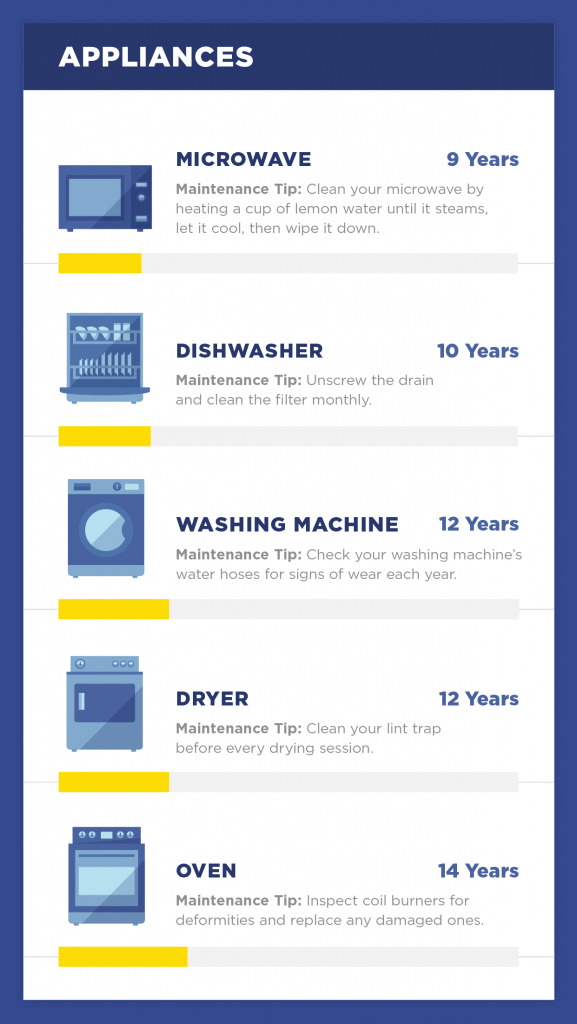
Appliances:
The appliances in your home are some of the easiest things to fix and some of the more inexpensive to replace. While some people replace appliances as newer technology emerges, it’s most cost-effective to use them for the duration of their lifespan.

A microwave can last a long time if properly cared for. Usually, they last anywhere from 5–15 years and sometimes even longer depending on usage. When using your microwave, clean it often and avoid slamming the door. Never run your microwave without something inside, as it can cause serious damage.
Depending on the make and model, a dishwasher can last anywhere from 7–12 years. If you start to notice your dishwasher isn’t washing well, give it a good cleaning before giving up on it.
To properly clean it, unscrew the drain and clean the filter monthly to prevent clogging. Once the filter is clean, empty the dishwasher completely (racks and all) and running it with a cup of distilled white vinegar inside it.
The average washing machine lasts between 10–15 years depending on the brand and how well it’s maintained.
To stretch its usable years further, check your washing machines water hoses for signs of wear or weakness a few times each year.
Similar to your washing machine, your dryer should last anywhere from 10–15 years. If you buy them together, they likely will be ready to replace around the same time. If you notice it’s making strange noises or emitting strange smells, it might be nearing the end of its life.
A good maintenance best practice is to clean your lint trap before every drying session.
Ovens these days will last anywhere from 10–20 years. Don’t wait until you start ruining meals to replace your oven.
To ensure it’s running properly, inspect coil burners for deformities and replace any damaged ones.
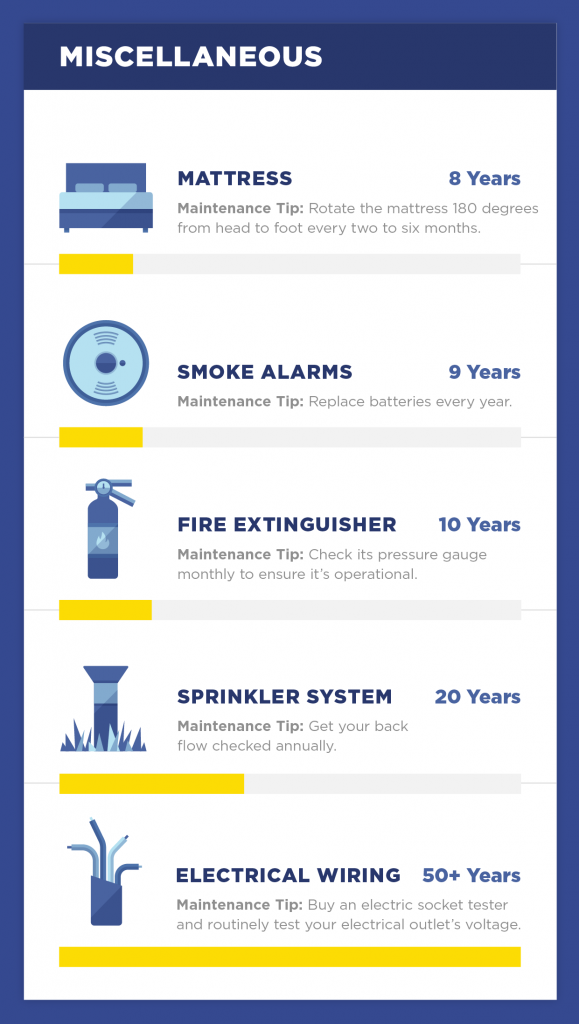
Miscellaneous:
There are other household items that may not necessarily be fixtures or appliances but are important and should be maintained nonetheless. Things like your mattress and sprinkler system are more obvious because you use them often. However, smaller things like smoke alarms, fire extinguishers and electrical wiring can cause damage if not properly maintained, so it’s important to keep your eye on them.

Your mattress is typically used more than most other things in your house and can collect dirt, dust and grime. It’s important to get a new mattress if yours starts to look or smell dirty, or if it’s losing its firmness.
Most people get a new mattress every 7–10 years which is a good rule to follow. Make your mattress last longer by rotating it 180 degrees from head to foot every two to six months.
Three out of five home-related fire deaths occur in a house that has malfunctioning smoke detectors. It’s important to not only replace batteries every year but to replace the detectors and alarms every 8–10 years.
- Fire extinguisher: 10 Years
It can be tough to tell how old your fire extinguisher is if you didn’t buy it yourself as some don’t have expiration or purchase dates on them.
A good way to tell if it’s working properly is to check its pressure gauge monthly to ensure the needle is in the green area of the pressure scale. If it’s damaged, has low pressure or you think it might be older than 10 years, it’s probably best to replace it.
- Sprinkler System: 20 Years
If you’re lucky enough to have a good quality sprinkler system it can last you anywhere from 10–30 years! Take good care of it to ensure you’re on the high end of that scale. Get your backflow checked annually and drain the system of water during the winter if you’re in an area that freezes.
- Electrical Wiring: 100+ Years
Old wiring can cause serious safety issues for you and your family. The good news is that wiring systems can last a lifetime if properly maintained. Buy an electric socket tester and routinely test your electrical outlets’ voltage.
If you start to notice low voltage, get a tingling sensation when you touch the walls, smell burning anywhere in your home or have ungrounded outlets around your house it might be time to replace it.
In general, as long as you properly maintain your appliances, fixtures and household items you should get fairly long lives out of most of them. If you also save the recommended 1% of your home’s value every year for repairs you won’t be blindsided when a costly repair does need your attention. Use this list to anticipate your product’s lifespans and enjoy stress-free home repairs.






